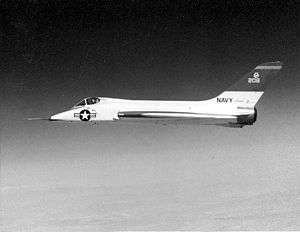Douglas F5D Skylancer
| F5D Skylancer | |
|---|---|
 | |
| Douglas F5D Skylancer prototype in use by NASA for Dyna-Soar abort training | |
| Role | Fighter aircraft |
| Manufacturer | Douglas Aircraft Company |
| First flight | 21 April 1956 |
| Retired | 1970 |
| Primary user | United States Navy |
| Number built | 4 |
| Developed from | Douglas F4D Skyray |
The Douglas F5D Skylancer was a development of the F4D Skyray jet fighter for the United States Navy. Starting out as the F4D-2N, an all-weather version of the Skyray, the design was soon modified to take full advantage of the extra thrust of the Pratt & Whitney J57 eventually fitted to the Skyray instead of the Westinghouse J40 originally planned.
Design and development
Soon the design became too different from the Skyray to be considered just a variation of it, and the aircraft was assigned a new designation as the F5D Skylancer. Almost every part of the airframe was modified, though the basic form remained the same as did the wing shape, though it became much thinner. The wing skinning was reinforced, correcting a problem found in the F4D. The fuselage was 8 ft (2.4 m) longer and area ruled to reduce transonic drag, being thinner in the region of the wing roots. Everything was shaped to reduce drag and increase stability at high speed.
Although the four 20 mm (.79 in) cannon in the wing roots were retained, primary armament was to be missiles or rockets; four AIM-9 Sidewinders or two AIM-7 Sparrows, and/or a battery of spin-stabilized unguided 2 in (51 mm) rockets.
Nine test airframes were ordered, with a 51-aircraft production order to follow. Production aircraft were to be powered by the more powerful J57-P-14 engine, while there were plans to use the even more powerful General Electric J79.
Operational history
The first flight was on 21 April 1956 and was supersonic; the aircraft proved easy to handle and performed well. After four aircraft had been constructed, however, the Navy cancelled its order. The stated reason was that the aircraft was too similar to the already-ordered Vought F8U Crusader, but it is believed by some historians that politics played as big a part; Douglas was already building a very large proportion of the Navy's planes, and giving them the F5D contract would have made it even closer to monopoly.[1] The project test pilot was Lt. Cmdr Alan B. Shepard Jr. whose report stated that it was not needed by the Navy.

NASA use
The four aircraft continued to fly in various military test programs. Two were grounded in 1961, but the other two: F5D-1 (Bu. No. 139208) NASA 212, later becoming NASA 708 and F5D-1 (Bu. No. 142350) NASA 213, later becoming NASA 802 continued to fly. Transferred to NASA in the early 1960s, one was used as a testbed for the American supersonic transport program, fitted with an ogival wing platform (the type eventually used on Concorde; data from the program was shared with the European designers). This aircraft was retired in 1968. NASA 802 was used for simulation of abort procedures for the X-20 Dyna-Soar, because it had a very similar shape and handling characteristics. Following the DynaSoar cancellation, it was used as a chase plane and for various other programs until it was retired in 1970.[2]
Survivors
- BuNo 139208 (NASA 708) still in NASA markings was part of Merle Maine's private collection in Ontario, Oregon until 2014.[2][3][4] The aircraft currently resides at Evergreen Aviation and Space Museum.
- BuNo 142350 (NASA 802) still exists at the Neil Armstrong Air and Space Museum at Wapakoneta, Ohio, since Neil Armstrong flew the aircraft during the Dyna-Soar research program.[5]
Specifications (F5D)
.gif)
Data from The American Fighter [6]
General characteristics
- Crew: 1
- Length: 53 ft 9¾ in (16.40 m)
- Wingspan: 33 ft 6 in (10.21 m)
- Height: 14 ft 10 in (4.52 m)
- Wing area: 557 ft² (51.7 m²)
- Empty weight: 17,444 lb (7,912 kg)
- Loaded weight: 24,445 lb (11,088 kg)
- Max. takeoff weight: 28,072 lb (12,733 kg)
- Powerplant: 1 × Pratt & Whitney J57-P-8 turbojet
- Dry thrust: 10,200 lbf (45 kN)
- Thrust with afterburner: 16,000 lbf (71 kN)
Performance
- Maximum speed: 990 mph (860 kn, 1,590 km/h, Mach 1.48)
- Range: 1,335 mi (1,160 nmi, 2,148 km)
- Service ceiling: 57,500 ft (17,500 m)
- Rate of climb: 20,730 ft/min (105.3 m/s)
- Wing loading: 43.9 lb/ft² (214 kg/m²)
- Thrust/weight: 0.65
Armament
- Guns: 4 × 20 mm (0.79 in) cannon
- Rockets: 72 × 2 in (51 mm) rockets
- Missiles:
- 4 × AIM-9 Sidewinder or
- 2 × AIM-7B Sparrow
Avionics
- X-24A radar
See also
- Related development
- Aircraft of comparable role, configuration and era
- Related lists
References
Notes
- ↑ Gunston 1981, p. 73.
- 1 2 "F5D-1 Skylancer". Dryden Flight Research Center. Retrieved June 13, 2010.
- ↑ Pizza, Katie (September 11, 2008). "Air Faire fun". Argus Observer. Ontario, OR. Retrieved September 13, 2010.
- ↑ "Merle Maine's Warbirds". Ontario Air Faire. 2010. Archived from the original on July 27, 2011. Retrieved September 13, 2010.
- ↑ http://www.armstrongmuseum.org/what-see
- ↑ Angelluci 1987, p. 191.
Bibliography
- Angelucci, Enzo. The American Fighter. Sparkford, Somerset, UK: Haynes Publishing Group, 1987. ISBN 0-85429-635-2.
- Ginter, Steve. Douglas F5D-1 Skylancer (Naval Fighters No. 35). Simi Valley, California: Ginter Books, 1996. ISBN 0-942612-35-3.
- Gunston, Bill. Fighters of the Fifties. Cambridge, UK: Patrick Stephens Limited, 1981. ISBN 0-85059-463-4.
- Winchester, Jim, ed. "Douglas F4D Skyray." Military Aircraft of the Cold War (The Aviation Factfile). London: Grange Books plc, 2006. ISBN 1-84013-929-3.
External links
| Wikimedia Commons has media related to Douglas F5D Skylancer. |